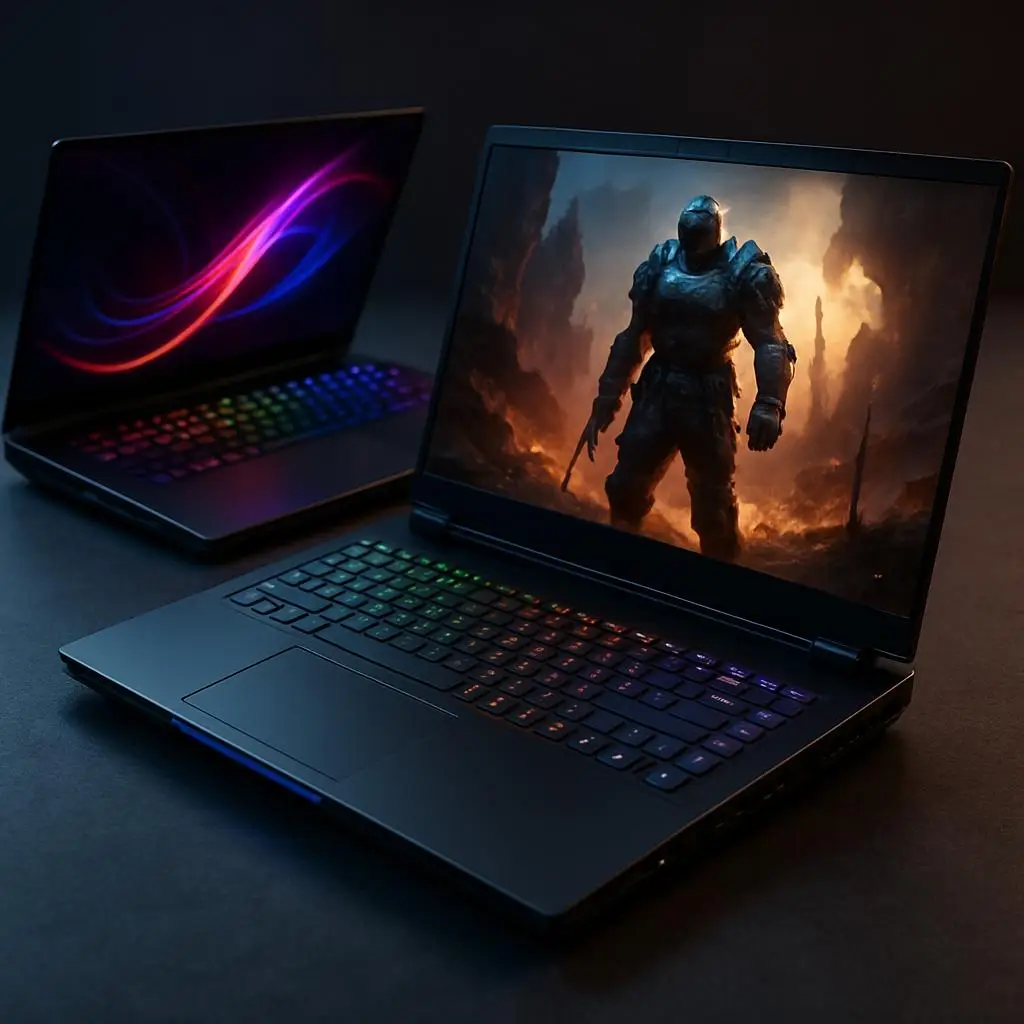Best gaming laptops are more than powerful PCs crammed into small chassis—they are balanced machines where thermal design, display quality, and battery strategy matter as much as raw benchmarks. As a reviewer who has logged hundreds of hours tuning profiles and measuring frametimes, I evaluate laptops the way players actually use them: docked on a desk, on a couch with a controller, and on the road between classes or client meetings. That lived context separates marketing hype from meaningful gains, helping you invest in high-performance notebooks that feel fast every single day, not just in synthetic tests.
Performance starts with the CPU and GPU handshake, but the secret sauce is power delivery and cooling headroom that let silicon sustain clocks without throttling. When a system can keep its boost for minutes, not seconds, the experience is smoother and more consistent in raids, ranked shooters, and open-world sessions. The Best gaming laptops therefore pair capable chips with smart fan curves, a MUX or Advanced Optimus solution, and firmware that prioritizes stable frametimes over peak spikes.
Thermals define comfort, and comfort defines how long you actually play. A well-engineered chassis spreads heat away from WASD and palm rests, while quiet fans under 45 dBA preserve immersion and make late-night matches roommate-friendly. I look for vapor chamber designs, large exhausts, and intake feet that lift the base; these details turn portable gaming devices into truly versatile companions for dorms, trains, and living rooms.
The screen is your window to victory, so refresh rate, response time, and color accuracy all count. Competitive players benefit most from 240–360 Hz panels with good overdrive that limits ghosting, while creators need wide-gamut coverage and solid brightness for color-critical edits between games. The top displays now add VRR support, which syncs frames to avoid tearing when your advanced graphics systems dip during dense firefights or ray-traced scenes.
Input and build quality are where daily satisfaction lives: crisp keyboards with 1.7–2.0 mm travel, smooth precision touchpads, and durable hinges that resist wobble. Thoughtful port placement keeps cables out of mousing zones, and a right mix—USB4/Thunderbolt, HDMI 2.1, 2.5 GbE, and a speedy card reader—supports livestream rigs, external monitors, and camera workflows. The small quality-of-life wins, like a physical webcam shutter and per-key lighting that remembers profiles, accumulate into a premium feel you notice every time you open the lid.
Battery life is not about marathon runs at max FPS; it is about reliable hours of notes, browsing, and media between outlets so your gaming machine doubles as a daily driver. Efficient iGPU modes, panel refresh toggles, and USB-C Power Delivery let you commute with a light charger and switch to the brick at home for full tilt. The Best gaming laptops do not force compromises—they let you live your day and then sprint when it is time to queue.
Value is contextual, and the best gaming laptops for one buyer may be overkill for another. If you mostly play esports titles, a mid-tier GPU in a cool, quiet chassis is often the smarter purchase than a hot-rod flagship; that is where gaming laptops best balance price, noise, and longevity. For big single-player epics or creator workflows, spending more on thermals, VRAM, and storage makes sense, but even then, a well-balanced system often outperforms raw spec sheets in real life.
Best gaming laptops decoded: specs, thermals, value
When I size up a machine, I start with sustained performance, not just a single-run score, because games and creative apps behave like endurance events. A CPU with strong efficiency cores and tuned boost behavior will keep background tasks from interrupting your aim or render, and that matters more than a fleeting max clock figure. The Best gaming laptops therefore prioritize power distribution and BIOS profiles that enable consistent delivery to both CPU and GPU under simultaneous load.
On the graphics side, TGP and cooling dictate how far the silicon can stretch, so look for total power budgets that match the chassis’ cooling reality. A 120–160 W configuration with solid airflow often outperforms a theoretically higher wattage in a cramped shell that throttles; that’s the truth behind advanced graphics systems on the road. VRAM is another lever—12 GB is a sweet spot for modern textures at 1440p, while ray tracing benefits from technologies like DLSS or FSR to stabilize frametimes.
Memory and storage are the day-to-day speed boosters: 16 GB is the entry for modern gaming, 32 GB feels headroom-proof for heavy multitasking, and 64 GB suits creators juggling timelines and renders. PCIe 4.0 NVMe drives cut load screens to seconds, and dual M.2 slots future-proof upgrades as games swell past 100 GB per title. I favor configurations with at least one accessible SO-DIMM and an extra SSD bay so your machine can grow with your library.
Thermal engineering is where manufacturers either earn your trust or waste your time. Vapor chambers and well-vented bottoms help expel heat without screaming fans, and a raised rear edge or included stand can turn a good design into a great one. Compared with smaller portable gaming devices, a proper laptop’s cooling headroom lets you run higher sustained clocks quietly, which is crucial in libraries, offices, and shared spaces.
Displays deserve a calibration-first mindset: a 240 Hz 1440p panel is the sweet spot for most, with response times that keep motion crisp and colors that do justice to HDR content. Variable refresh technology smooths dips, 300+ nits hold up against office lighting, and flicker-free backlights reduce eye strain during long sessions. Creator-focused panels should hit strong coverage of sRGB and P3 so your edits align with client expectations without external monitors.
Ports and connectivity turn a laptop into a command center, so assess your ecosystem before you buy. Thunderbolt or USB4 enables fast external drives and docks, HDMI 2.1 feeds 4K 120 Hz TVs for couch play, and 2.5 GbE keeps ping stable when Wi‑Fi is crowded. Wi‑Fi 6E or 7 makes a difference in dense apartments, and a front-placed combo jack plus a rear power port reduce cable snags during streams or work calls.
Upgradability, serviceability, and warranty terms are the longevity trifecta. A chassis that opens with standard screws, labeled ribbon cables, and replaceable fans cuts future costs and keeps thermals fresh after years of dust. As new titles push texture sizes and CPU threads, the machines that age best are the ones you can tune and expand; for many shoppers eyeing best gaming laptops for 2025, this practical path beats chasing the highest launch-day spec, and it is exactly where gaming laptops best deliver lasting value.
Play longer, travel lighter: best gaming laptops for 2025
If you travel frequently, weight, charger size, and battery tuning can matter more than a few extra FPS. A sub-2.2 kg chassis with efficient iGPU mode, a 240 Hz 1440p panel, and USB-C charging up to 100 W will glide through airports and still handle ranked nights in hotels. These thoughtful touches turn performance rigs into portable gaming devices that fit a lifestyle of commutes, coffee shops, and weekend LANs.
Students and professionals should prioritize balance: a quiet keyboard, sober design, and fast wake all make lectures and meetings smoother. Docking at home to a 27-inch monitor gives you the best of both worlds—focus and ergonomics by day, high refresh mayhem by night. In that hybrid life, the best gaming laptops quietly double as productivity powerhouses, which is where their true value compounds across semesters and sprints.
Creators have special needs that overlap with gamers but extend into color accuracy, storage flexibility, and stable exports under heat. Look for wide-gamut displays, two NVMe slots, and encoders that accelerate timelines without melting your lap. When tuned right, high-performance notebooks give you snappy edits and stutter-free gaming, so your off-hours joy does not sabotage your on‑hours delivery.
Esports enthusiasts should obsess over input feel and latency as much as GPU tier. Fast panels, low-latency paths, and consistent cooling ensure spray control feels identical in round 1 and round 20, minimizing performance drift as heat builds. Marrying those traits with advanced graphics systems produces a competitive edge that outlasts flashy spec stickers and pays dividends on the ladder.
Longevity comes from maintenance as well as parts: keep vents clean, repaste or replace pads when temps creep up, and update firmware responsibly. Good fan profiles save your hearing long-term, while undervolting within safe limits can lop degrees off peak temps without sacrificing stability. Treating your purchase like a precision tool makes it feel new long after the honeymoon period fades.
Budget strategy is about targeting features that move the needle, not chasing every buzzword. For many shoppers comparing best gaming laptops for 2025, the smarter spend is on cooling, display quality, and storage headroom rather than a marginal GPU tier bump. In real use, that’s how gaming laptops best stretch dollars—by staying cool, quiet, and responsive through finals week, product launches, and marathon patches.
In the end, the Best gaming laptops are those that fit your games, your desk, and your day, not someone else’s checklist. If you play shooters and travel, prioritize a crisp 240 Hz panel, great thermals, and USB‑C charging; if you live for cinematic RPGs and mods, lean into VRAM, sustained power, and expansive storage. Anchor your choice in how you actually live and play, and the best gaming laptops will feel like a tailored upgrade every time you press the power button.













